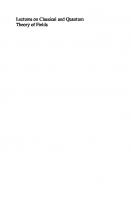From c-Numbers to q-Numbers: The Classical Analogy in the History of Quantum Theory [Reprint 2019 ed.] 9780520328280
276 53 28MB
English Pages 418 [407] Year 2020
Recommend Papers
![From c-Numbers to q-Numbers: The Classical Analogy in the History of Quantum Theory [Reprint 2019 ed.]
9780520328280](https://ebin.pub/img/200x200/from-c-numbers-to-q-numbers-the-classical-analogy-in-the-history-of-quantum-theory-reprint-2019nbsped-9780520328280.jpg)
- Author / Uploaded
- Olivier Darrigol
File loading please wait...
Citation preview
From ¿-Numbers to ^-Numbers
C A L I F O R N I A STUDIES IN T H E H I S T O R Y O F SCIENCE J. L. H E I L B R O N , Editor The Galileo
Affair:
A Documentary
History,
edited and translated by
Maurice A. Finocchiaro The New World, 1939-1946 (A History of the United States Atomic Energy Commission, volume 1), by Richard G. Hewlett and Oscar E. Anderson, Jr. Atomic
Shield, 1947-1952
(A History of the United States Atomic Energy
Commission, volume 2), by Richard G. Hewlett and Francis Duncan Atoms for Peace and War, 1953-1961: Eisenhower and the Atomic Energy Commission (A History of the United States Atomic Energy Commission, volume 3), by Richard G. Hewlett and Jack M . Holl Lawrence
and His Laboratory:
Laboratory,
Volume
A History
of the Lawrence
Berkeley
1, by J. L. Heilbron and Robert W . Seidel
Scientific Growth: Essays on the Social Organization and Ethos of by Joseph Ben-David, edited by G a d Freudenthal Physics and Politics in Revolutionary
Russia,
Science,
by Paul R. Josephson
From c-Numbers to q-Numbers: The Classical Analogy Quantum Theory, by Olivier Darrigol
in the History
of
From ¿-Numbers ¿/-Numbers The Classical Analogy in the History of Quantum Theory
Olivier Darrigol
UNIVERSITY OF CALIFORNIA PRESS Berkeley • Los Angeles • Oxford
University of California Press Berkeley and Los Angeles, California University of California Press Oxford, England Copyright © 1992 by The Regents of the University of California
Library of Congress Cataloging-in-Publication Data Darrigol, Olivier. From c-numbers to g-numbers : the classical analogy in the history of quantum theory / Olivier Darrigol. p. cm. — (California studies in the history of science) Includes bibliographical references and index. ISBN 0-520-07822-5 1. Q u a n t u m theory—-History. I. Title. II. Series. QC173.98.D37 1992 530.1'2'09—dc20 91-42469 CIP
Printed in the United States of America 123456789 The paper used in this publication meets the minimum requirements of American National Standard for Information Sciences—Permanence of Paper for Printed Library Materials, ANSI Z39.48-1984 ( p q )
A mes Parents
Contents
Acknowledgments Conventions and Notations Introduction
xi xiii xv
PART A. PLANCK'S RADIATION THEORY
1
Introduction
3
1. C o n c e p t s o f G a s T h e o r y M a x w e l l ' s Collision Formula Boltzmann's Irreversible Equations T h e N a t u r e of Irreversibility Summary 2. P l a n c k ' s A b s o l u t e I r r e v e r s i b i l i t y Against A t o m s Blackbody Radiation Planck's Resonators Summary 3. O n I r r e v e r s i b l e R a d i a t i o n P r o c e s s e s A Polemic with Boltzmann N a t u r a l Radiation
7 7 13 15 19 22 22 24 29 36 39 39 41
vii
Contents
Vlll
Planck Versus Boltzmann Summary
4. The Infrared Challenge T h e Second Derivative of the Resonator Entropy Boltzmann's Combinatorics Quantified Chaos Quantum Continuity Summary and Conclusions
51 54
57 57 62 66 70 73
PART B. THE CORRESPONDENCE PRINCIPLE
79
Introduction
81
5. T h e Bohr Atom (1913-1916) Horrid Assumptions Confirmations and Perturbations Periodic Systems Summary
6. Postulates and Principles Multiperiodic Systems Einstein's Transition Probabilities " O n the Quantum Theory of Line Spectra" T h e Meaning of the Correspondence Principle: Magic or Reason? Summary
7. Harmonic Interplay Beyond Multiperiodic Systems Building Atoms Systematic Calculations Summary
8. A Crisis T h e Catastrophe of Helium Orbit-Killers in the Zeeman Jungle T h e Exclusion Principle Summary
9. The Virtual Orchestra T h e Theory of Bohr, Kramers, and Slater (BKS) Dispersion Theory Intensities
85 85 89 93 98
102 102 118 121 137 145
150 150 154 168 171
175 175 179 201 209
213 214 224 235
Contents T h e Fall of the B K S Theory Summary 10. M a t r i x M e c h a n i c s From Copenhagen to Gòttingen Umdeutung Guiding Principles Epilogue Summary and Conclusions
IX
246 255 260 260 263 273 276 280
PART C. DIRAC'S Q U A N T U M MECHANICS
285
Introduction
287
11. C l a s s i c a l B e a u t y
291
Noncommutative Geometry T h e Lesson of Relativity T h e Art of Action-Angle Variables Summary 12. Q u e e r N u m b e r s Poisson Resurrected T h e Canonical M e t h o d Q u a n t u m Algebra Summary 13. Q u a n t u m B e a u t y Schròdinger's Equation Transformations Welcome to Copenhagen Summary and Conclusions
Bibliographical Guide
291 297 304 306 309 309 317 319 325 329 329 333 343 345
349
A b b r e v i a t i o n s U s e d in C i t a t i o n s a n d in t h e Bibliography
354
Bibliography of Secondary Literature
356
Bibliography of Primary Literature
368
Index
381
Acknowledgments
I first conceived the project of this book three years ago, during a conversation with John Heilbron in the Berkeley hills. Since then, and before, John has encouraged me in many ways: commenting on my w o r k , giving me professional advice, and inviting me for long stays at an ideal working place, the Office for the History of Science and Technology at Berkeley. There I made friends with E d w a r d Jurkowicz, without w h o m the project of writing a book in English would have been beyond my reach. N o t only did Ed correct and clarify my English, but his highly detailed comments helped to structure and strengthen many of my arguments. In France I received the highest intellectual stimulation f r o m Catherine Chevalley, who discussed with me several issues of the history and philosophy of q u a n t u m theory, let me read her w o r k on Bohr (Chevalley 1991a) prior to publication, and commented on large portions of my manuscript. Since history of q u a n t u m theory is not a new field of research, I have sought advice from competent scholars. N o r t o n Wise, a perceptive analyst of Bohr's early work and also an expert on analogical thinking, offered several suggestions for improving my manuscript. T h e convergence of our views on Bohr's role m a d e our exchange particularly pleasant. T h e part of my manuscript on Dirac's q u a n t u m mechanics benefited f r o m comments by the Danish historian Helge Kragh, w h o has recently published a major biography of Dirac, and by the philosopher E d w a r d MacKinnon, w h o has long been interested in Dirac's methodology.
XI
Xll
Acknowledgments
Some physicist friends have been kind enough to check the more technical content of my manuscript. Jean-Michel R a i m o n d , an authority on atomic physics, read my considerations on the old spectroscopy of fine structure and anomalous Zeeman effects. Bruno Jech, a professor of physics and historian, went through the arcana of my presentation of Planck's radiation theory. I have also tested the reaction of historians of science who have no specialized knowledge of the history of quantum theory. M a r i o Biagioli suggested improvements in the general introduction of this book; Mathias Dórries helped prune numerous obscurities in the nontechnical summaries. All my research has been done under the auspices of the Centre National de la Recherche Scientifique, both in Paris and during my stays abroad. M y research director, the philosopher-physicist Bernard d'Espagnat, has been, from the beginning, supportive of the type of work in which I was engaged. I have much benefited f r o m his exceptionally deep understanding of the foundations of quantum theory. I o w e special thanks to the authorities of C N R S w h o gave me the freedom to do my w o r k in the best environments. In Paris I have profited from the intellectual ambience at R E H S E I S (équipe du C N R S pour les Recherches en Epistémologie et Histoire des Sciences et des Institutions Scientifiques). In this group, I have especially appreciated the guidance of Michel Paty and Roshdi Rashed. At the final stage of this project, the collaboration of my sponsoring editor, Elizabeth Knoll, of the University of California Press, has been pleasant and constructive. Some anonymous reviewers of her choosing made valuable suggestions for improving my manuscript. Aage Bohr has kindly granted me permission to quote from his father's unpublished manuscripts and letters (which are deposited in the Bohr Archive in Copenhagen). For Heisenberg's unpublished letters (which belong to the Heisenberg Archive in Munich) I o w e a similar favor to Helmut Rechenberg. H o w e v e r small my project and modest the results, my debts appear to be extensive and numerous. I am very thankful to the colleagues and friends just mentioned, and to all those w h o , by their friendship or their research, helped me in an indirect, but invaluable, manner.
Conventions and Notations
Vector notation is used throughout the book, even when it is anachronistic, for instance in Maxwell's and Planck's cases. Knowing that Maxwell used points in a geometric space (in the context of his dynamic theory of gases) and that Planck used Cartesian coordinates, my reader will easily imagine a more authentic form of their equations. In conformity with the convention found in most works described in this book, Gaussian units are employed, which gives Maxwell's equations (in vacuo) the form V • E = 4np V x E =
V • B = 0
1 dB c dt
Then the Poynting vector is given by (c/47r)E X B and the energy density by (1/8TT)(£2 + B2). For Hamiltonian systems collective coordinates q and p are introduced according to






